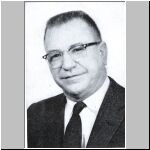(1890-1975)
By A. L.Taylor


Gerald Thorne was born in
Vernal, Utah on July 6,1890, and died in Madison, Wisconsin on February
16, 1975.
As he wrote in the Nematology News Letter [13(2):13-15], he left the
home ranch in Utah mountains in 1911 to become a schooll teacher. In 1915,
he was herding sheep and studying to increase his teaching efficiency.
He soon decided to attend the Utah Agricultural College at Logan where
he studied under Dr. E. G. Titus and H. R. Hagan in the Department
of Entomology and Zoology. In 1917, he said "Dr. Titus took me to
a sugar beet field, pointed out an area where the beets had died or were
severely stunted and showed me white females clinging to the roots." As
he made this demonstration he said, "No one in this country is working
on these things. You had better get busy on them." Following his advice,
infested beets were taken to the laboratory and my career in nematology
had begun." In 1917, Dr. Titus transferred to Sugar Plant Investigation
of the U.S. Department of Agriculture, and in 1918 he hired Thorne as Scientific
Assistant devote full time to study of sugar beet nematodes.
Field work was not as easy in 1918as it became later when automobiles were more common, so Jerry Thorne made surveys by riding trains, walking, and hitching an occasional ride on a farm wagon. His work and growing knowledge of sugar beet nematodes brought him into contact with the sugar beet processing companies, and this led to a widespread educational project, involving everyone who had anything to do with production of sugar beets. The educational campaign gathered momentum in the 1920's and did not end until the early 1930's, but by that time, the idea of control of sugar beet nematodes by crop rotation had been thoroughly established. Both farmers and sugar companies were convinced that crop rotation was necessary to save the industry. The campaign has been forgotten, but the fundamental ideas remain and are still worth millions of dollars per year to the beet sugar industry.
When he was not busy with the study of sugar beet nematodes, Jerry worked on the taxonomy of the free-living nematodes he encountered in his examination of sugar beet soil. His first publication was a U.S. Department of Agriculture Circular, "The length of the dormancy of the sugar beet nematode in Utah" (1923). His second was "Utah nemas of the genus Mononchus" (1924), and the third was his Master's Thesis, "The genus Acrobeles von Linstow" (1925), in which he described thirty new species. This was followed by a long list of publications on taxonomy and control, and a textbook "Principles of Nematology" (1961). His last publication was "Nematodes of the Northern Great Plains, Part II," published in February, 1974, 51 years after his first paper.
In 1926, Gerald Thorne was
transferred to the Division of Nematology under Dr. N. A. Cobb. When he
retired from the U.S.D.A. in 1956, he became a professor at the University
of Wisconsin and retired again in 1963. For Jerry, retirement was difficult
to define. He worked in many places after his second retirement, including
Puerto Rico, Brookings, South Dakota, Florida, and elsewhere, and actively
worked up to January, 1975.
Jerry Thorne is mourned by his wife of 40 years,
Zelda, by his two sons, and by a long list of friends, students, and nematologists
who he helped in many ways. Among these is the writer, who traces his whole
career in Nematology to aquaintance with Jerry on the range of the Potomac
Archers in Washington, D.C. in 1929. He and his time were unique, and he
made the very best use of his opportunities and his unlimited energy.